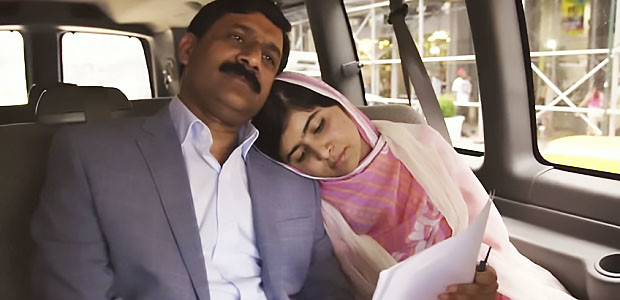Having saved the world so many times, how many superheroes have you seen on the cover of Time magazine? That’s right, they don’t exist. But real heroes do and they don’t need superpowers or a fancy costume to stand in the face of injustice. As a defender of truth and equality in the times we live in, this is the incredible true story of Malala Yousafzai, a real hero whose only weapon is indelible courage.
From Academy Award winning director Davis Guggenheim and produced by Imagenation Abu Dhabi, He Named Me Malala is part documentary, part animation, and part live action, but wholly narrated by Malala and her father Ziauddin Yousafzai. Although the use of animation is questionable, these segments are used as plot points leading up to the day when Malala was shot in the head by the Taliban. If not, Guggenheim would have had to reenact those moments using real actors but at the risk of discounting the authenticity of this documentary. Along with actual news footage and still images, much of the story is a reiteration of her courage, her ordeal, her survival, and her dedication as a right-to-education activist. While this might seem all too familiar to anyone following the news, the documentary doesn’t feel scripted or even overladen with praise. And why shouldn’t it be? This is about the assassination attempt on a 15-year-old girl whose only crime was speaking out on her basic right to an education.
Inspired by her memoir I Am Malala, the film begins in Birmingham, United Kingdom, in 2013, where the Yousafzai family is based post recovery period. Although you don’t see a scar, Malala bears a lopsided smile whenever she is asked a question. There is sadness in her eyes along with bashful insecurity but also wisdom and an inner strength much beyond her age. “Three years have passed”, she recalls, not of the attempt on her life, but having left her beautiful home in the Swat Valley province of Pakistan. Surrounded by Afghani Mountains, we are shown images of this scenic region (which is always presented as a place of bloodshed and massacre by the media) before Malala begins her story. This is also where the narrative shifts from Malala to her father, beginning with his version of a ‘love marriage’ to Malala’s mother. As a self-taught public speaker, Ziauddin’s story is as incredible as his daughter Malala’s. While it’s clear where the latter gets her courage and insight from, it’s the development of symbiotic father-daughter relationship that makes this a documentary that must be seen.
Riveting, and at times overwhelming, He Named Me Malala is a delight to watch, and so is Malala Yousafzai. Guggenheim could have stuffed this film with geopolitical propaganda and ended it with a bleeding cry for justice. When asked if they caught the person who shot his daughter, Ziauddin replies “Not a person, but an ideology”. Likewise, Malala has her own quips, and along with her brothers and her father add refreshingly funny moments given the subject matter. At the same time and given her status as a public figure, at no point does Malala seem like a celebrity, nor does she see herself that way. What you do see is a shy teenager but one that is utterly brave and honest with the kind of raw dedication that outflanks millions, possibly billions, of people her age. The fact that Malala was featured on Time magazine twice, followed by her becoming the youngest ever recipient of a Nobel Peace Prize in 2014 proves my last statement.
He Named Me Malala is highly inspirational and the type of film where you clap in the end, only to realize that you’ve clapped too early. Malala is only 18 now, but she has achieved far more than any of us ever will. That itself is worth a standing ovation and I wish her a long life of success in her fight for equality and education with many more accolades to come.
Rating: 




